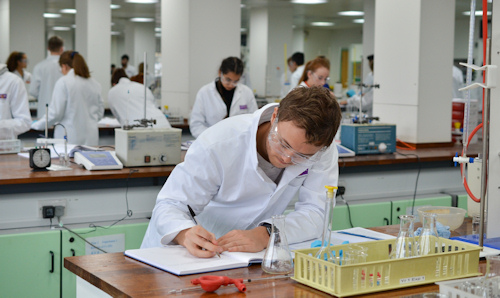
Inorganic chemistry
Our researchers
- Ralph Adams
- Martin Attfield
- Michael Baker
- Alice Bowen
- Alan Brisdon
- Nicholas Chilton
- David Collison
- Conrad Goodwin
- Xue Han
- Nikolas Kaltsoyannis
- Stephen Liddle
- Francis Livens
- Eric McInnes
- David Mills
- Louise Natrajan
- Imogen Riddell
- Martin Schröder
- Floriana Tuna
- Darren Willcox
- Richard Winpenny
- Sihai Yang
Inorganic chemistry at Manchester covers a multidisciplinary array of research topics in molecular chemistry, materials chemistry, and radiochemistry across the entire Periodic Table.
Particular research strengths include:
- molecular and environmental chemistry of the lanthanides and actinides;
- molecular magnetism;
- homo- and heterogeneous catalysis mediated by novel transition metal and main group catalysts;
- bioinorganic chemistry;
- the application of advanced spectroscopic and magnetic techniques to probe the electronic structure of metal complexes;
- supramolecular capsules and functional porous materials.
Examples of our different areas of expertise are listed below.
Analytical techniques for trace radioactive nuclides
Scott Heath develops analytical techniques for trace radioactive nuclides and control of contaminants in water-cooled nuclear reactor cooling circuits.
D and f-block electronic structure
Floriana Tuna's interests lie in the study of the electronic structure and magnetism of d and f-block complexes, using principally EPR spectroscopy and magnetometry.
Fluorine chemistry
Alan Brisdon develops fluorine chemistry across main group and transition metal boundaries, with a particular emphasis on the synthesis of novel organofluorinated phosphine complexes of transition metals for catalysis.
Lanthanide and actinide complexes
Stephen Liddle focuses on the structure, bonding and magnetism of lanthanide and actinide complexes, with a focus on species containing metal-ligand multiple bonds, as well as the activation and derivatisation of small molecules, such as dinitrogen.
David Mills’ research focuses on the synthesis of lanthanide and actinide complexes with unusual geometries and bonding regimes, which can engender remarkable physical properties and reactivity profiles.
Molecular and electronic structure of coordination complexes
David Collison investigates the molecular and electronic structure of coordination complexes as models for biological systems, with a particular emphasis on the use of EPR spectroscopy.
Molecular magnetism and quantum information
Eric McInnes has broad interests in studying molecular magnetism for applications in quantum information processing and storage, with a particular focus on studying - and f-block complexes with EPR spectroscopy and magnetometry.
Novel main group electrophiles
Michael Ingleson researches the fundamental design and application of novel main group electrophiles and inexpensive transition metals to stoichiometric organic transformations, catalysis and photo-active polymers and materials.
Novel photoactive transition metal
Benjamin Coe explores the synthesis of novel photoactive transition metal and organic compounds, with an emphasis on non-linear optical, electro-optic modulation and dye applications.
Porous materials
Sihai Yang researches the development of novel, functional porous materials for applications in catalysis, biomass utilisation, energy storage, separations and conductivity.
Protein stabilising
Using supramolecular chemistry, Imogen Riddell develops novel encapsulation methods to stabilise proteins and probe how biomolecules interact with synthetic constructs.
Radionuclide microbial transformations
Francis Livens investigates microbial transformations of radionuclides and mineral surface reactions.
Louise Natrajan investigates microbial transformations of radionuclides, as well as new spectroscopic techniques for finger-printing actinide ion speciation in solution.
Radionuclide biogeochemistry
Gareth Law researches radionuclide biogeochemistry, waste disposal, contaminated land management and nuclear forensics, with a particular focus on using X-ray absorption techniques.



